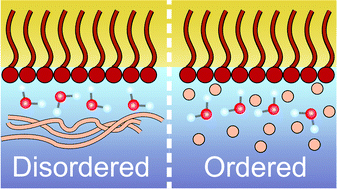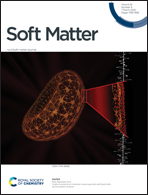Dynamic effect of polymers at the surfactant–water interface: an ultrafast study†
Abstract
Interfaces play a role in controlling the rates and outcomes of chemical processes. Characterizing the interactions at heterogeneous interfaces is critical to developing a comprehensive model of the role of interfaces and confinement in modulating chemical reactions. Reverse micelles are an ideal model system for exploring the effect of encapsulated species on interfacial environments. Here, we use a combination of ultrafast two-dimensional infrared (2D IR) spectroscopy and molecular dynamics (MD) simulations to characterize the picosecond interfacial dynamics in reverse micelles (RMs) containing acrylamide monomers and polyacrylamide polymers within the aqueous phase. The ester carbonyl vibrations of the sorbitan monostearate surfactants are examined to extract interfacial hydrogen-bonding populations and dynamics. Hydrogen bond populations at the ester carbonyl positions remain unchanged with the inclusion of either polymer or monomer species. Hydrogen-bond dynamics are not altered with the addition of monomer but are slowed down twofold in the presence of encapsulated polyacrylamide polymer species as a result of polymer chains partially localizing to the interface. These findings imply that kinetics of reactions that occur at interfaces or in confined environments could be modulated by interfacial localization of the different components.

- This article is part of the themed collection: Soft Matter Emerging Investigators Series


 Please wait while we load your content...
Please wait while we load your content...